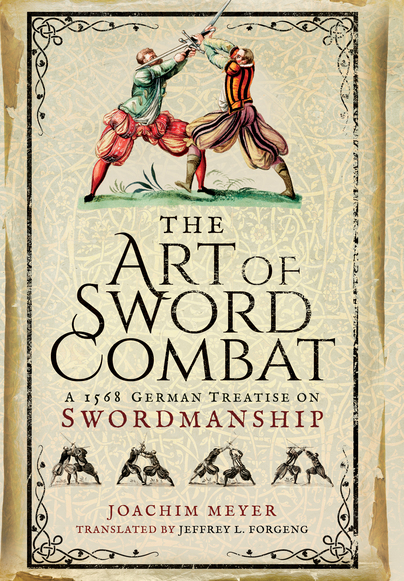The Art of Sword Combat (Hardback)
A 1568 German Treatise on Swordmanship

Pages: 208
Illustrations: 32
ISBN: 9781473876750
Published: 22nd June 2016
Last Released: 11th July 2023
(click here for international delivery rates)
Need a currency converter? Check XE.com for live rates
| Other formats available - Buy the Hardback and get the eBook for £1.99! | Price |
|---|---|
| The Art of Sword Combat ePub (14.7 MB) Add to Basket | £6.99 |
Following the success of Jeffrey L. Forgeng’s translation of Joachim Meyer’s The Art of Sword Combat, the author was alerted to an earlier recension of the work which was discovered in Lund University Library in Sweden. The manuscript, produced in Strassburg around 1568, is illustrated with thirty watercolour images and seven ink diagrams. The text covers combat with the longsword (hand-and-a-half sword), dusack (a one-handed practice weapon comparable to a sabre), and rapier. The manuscript’s theoretical discussion of guards is one of the most critical passages to understanding this key feature of the historical practice, not just in relation to Meyer but in relation to the medieval combat systems in general. The manuscript offers an extensive repertoire of training drills for both the dusack and the rapier, a feature largely lacking in treatises of the period as a whole but critical to modern reconstructions of the practice. The translation also includes a biography of Meyer, much of which has only recently come to light, as well as technical terminology, and other essential information for understanding and contextualizing the work.
The Art of Sword Combat by Joachim Meyer – A 1568 German Treatise on Swordmanship – is a must-have book for anyone with an interest in medieval history. It is such a wonderful piece of history, well worth reading and engaging with. The book shows the 30 watercolour images from the original book, which are a bit funny and incredibly interesting. On top of that there are also 7 diagrams in ink, which are interesting from another point of view, as they look very mathematical and precise.
Coffee and Books
When it comes to books published in the 16th century, it’s easy to imagine that all of them were either bibles or religious books, but the reality is different, publishers printed books on different topics, from dog training to sword combat as a sport, not for battle. I am delighted that there are contemporary translations that are still in print, to show us the complexity of Early Modern Europe.
The Art of Sword Combat was translated by Jeffrey L. Forgeng and it starts with a short biography of Meyer, his work and family life. The book covers fighting with three types of swords, but only one was used in battles, the rapier, the other two are for sport only, which are the long sword and the dusack.
In the manuscript there are training drills described for all three swords. There are lists of different cuts and, very helpful, a glossier at the end with details on what those cuts, guards, and other terms really mean.
5 stars
Read the full review here
This is the most in-depth account of sword technique we've seen, and military history buffs will find an awful lot to enjoy here. If you're interested in learning more about what many would call a lost art, then this translated work is an excellent place to start.
History of Royals, September 2016
If you’re interested in how people actually fought in the Early Modern Age, or just want to be able to visualize the duel between Romeo and Tybalt, The Art of Sword Combat is a book that will tell you everything you need to know.
Medievalists.net
Read the full review here!
About Joachim Meyer
Joachim Meyer was born in Basel in Switzerland in approximately 1537, possibly the son of Jacob Meyer, a stationer, and Anna Freund. He became a burgher of Strasbourg by marrying a widow in 1560, most likely during his apprenticeship as a cutler. He made a living as both a cutler and a professional fencer until 1570, in which year he published his Art of Combat – the book that made him famous. The making of this book, however, left him deeply indebted, and the search for potential buyers led him to leave Strasbourg and work as a Master-of-Arms at the court of the Duke of Schwerin. Unfortunately, he died shortly after his arrival, on 24 February 1571, at the age of just thirty-four, leaving the burden of his debt to his widow and brother-in-law.















